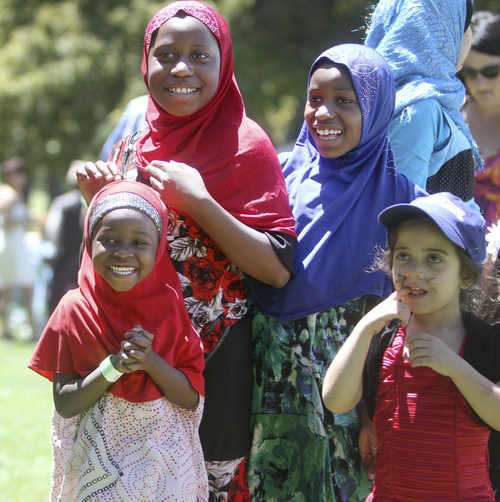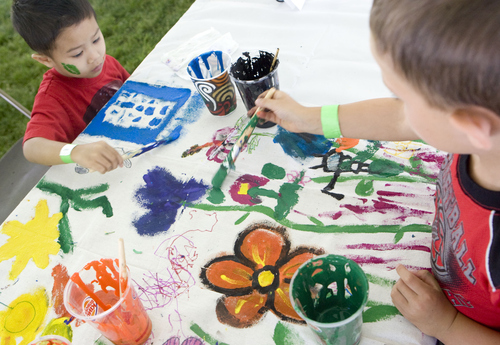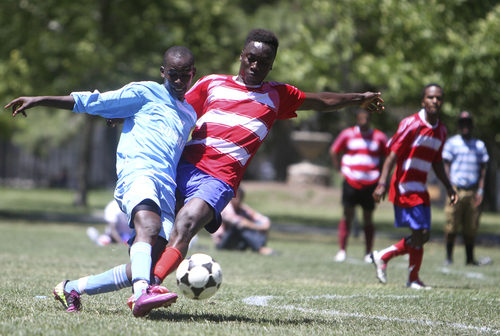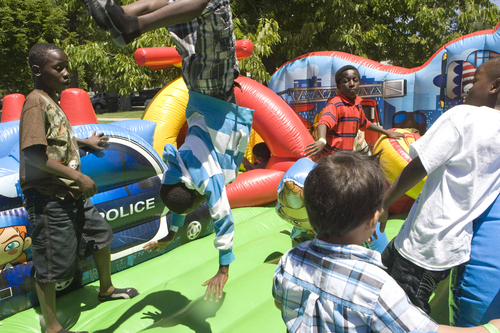This is an archived article that was published on sltrib.com in 2013, and information in the article may be outdated. It is provided only for personal research purposes and may not be reprinted.
If you educate a refugee woman, the ripple effect can change the destiny of a family, a clan and even a whole community.
That's the view of Bhim Sapkota, a Utah activist for Bhutanese women and the first recipient of the Aspen Award, given to a person who has improved the life of refugee women during the past year.
Sapkota started a literacy project for women during her 18 years in a Nepalese refugee camp, she said Saturday. When she moved to Utah four years ago with her husband and two children, she began to teach English to other refugee women.
The Bhutan mother received her award Saturday during the 2013 World Refugee Day at Liberty Park in Salt Lake City.
Hundreds of refugees from dozens of countries gathered in the park to celebrate their cultures, to dance, party and play soccer.
A group of Burundi drummers dazzled the crowd by carrying their giant instruments on their heads and then eliciting deep and rhythmic sounds from them. A group of Philippine Muslim dancers in gold-trimmed costumes used bamboo sticks and bells to act out the story of a famous prince and princess, a story typically told in religious ceremonies. Throughout the day, Africans watching sometimes broke into exuberant movements in their seats.
The day also offered a global marketplace where refugees offered their wares and services: woven rugs, fans, beads, necklaces, clay bulls and, of course, henna painting.
Early in the day 10 refugees were sworn in as U.S. citizens, standing before a backdrop of 20 national flags, including the American Stars and Stripes. In a moving ceremony, they swore their allegiance to their new country.
Thurl Bailey, former Jazz center and the day's honorary chairman, read a proclamation from Gov. Gary Herbert, noting the contribution refugees have made to the state.
More than 50,000 have arrived since the Vietnam War, and 11,000 since 2000.
"As I look out and see the diversity of peoples and cultures coming together," Bailey said, "it warms my heart."
Sapkota said she was honored by the recognition, named for a native Utah tree whose roots grow together in a common ball.
The award is the brainchild of Elizabeth Hendrix and Sarah Balland, staff members at the Refugee and Immigrant Center at the Asian Association of Utah.
"There haven't been a lot of targeted efforts to address the unique needs of refugee women," Hendrix said.
Hendrix and Balland said challenges include changes in women's roles from their native country to here; different employment and work expectations; altered family dynamics; and issues with reproductive health.
When the women were asked about their priorities, Balland reported, the women largely listed "making sure their kids were healthy, safe and successful in school."
They also thought the preservation of their culture was important.
Now Hendrix and Balland work to find volunteers, programs and staff members of various agencies to address those concerns.
Leila Safi, who was helping staff a food booth, came to Utah from Afghanistan with her family 11 years ago. Now at Highland High School, the well-spoken young woman says she likes her adopted home but has occasionally been hassled for wearing a head scarf.
"They think I don't know anything or that I was forced to do this," she says. "But I chose it. I like wearing the scarf."
Indeed, educating the community about cultural differences is part of the day's goal, said Gerald Brown, Utah state-refugee coordinator.
"Refugees have survived some horrific circumstances," he said, "and we want to recognize their courage and resilience."
But it's also important for refugees "to integrate and be part of the Utah community," he said, "and that will not happen until the mainstream community recognizes their strengths and abilities and doesn't just see them as victims."
Integration, he said, "is the prize."















